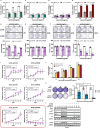Targeting the HER2-ELF3-KRAS axis: a novel therapeutic strategy for KRASG13D colorectal cancer
- PMID: 40340861
- PMCID: PMC12063335
- DOI: 10.1186/s12943-025-02343-5
Targeting the HER2-ELF3-KRAS axis: a novel therapeutic strategy for KRASG13D colorectal cancer
Abstract
Colorectal cancer (CRC) is one of the most prevalent cancers worldwide, with KRAS mutations playing a significant role in its tumorigenesis. Among the KRAS variants, the G13D mutation is associated with poor prognosis and distinctive biological behaviors. This study focuses on the role of HER2, a critical prognostic and predictive biomarker, in modulating the unique characteristics of KRASG13D-mutated CRCs. We identified a novel transcriptional regulatory network involving HER2, ELF3, and KRAS, with ELF3 acting as a key transcription factor (TF) that regulates KRAS expression under conditions of HER2 overexpression. Our findings reveal that this HER2-ELF3-KRAS axis is exclusively activated in KRASG13D, driving aggressive oncogenic features and conferring resistance to cetuximab (CTX) therapy. Through comprehensive analysis of gene expression profiles, we demonstrated that HER2 is a crucial therapeutic target specifically for KRASG13D CRCs. To explore this further, we introduced YK1, a small molecule inhibitor designed to disrupt the ELF3-MED23 interaction, leading to the transcriptional downregulation of HER2 and KRAS. This intervention significantly attenuated the HER2-ELF3-KRAS axis, sensitizing KRASG13D CRCs to CTX and reducing their tumorigenic potential by inhibiting the epithelial-to-mesenchymal transition process. Our study underscores the importance of HER2 as a key determinant in the unique biological characteristics of KRASG13D CRCs and highlights the therapeutic potential of targeting the HER2-ELF3-KRAS axis. By presenting YK1 as a novel pharmacological approach, we provide a promising strategy for developing tailored interventions for KRASG13D CRCs, contributing to the ongoing efforts in precision medicine for CRCs.
Keywords: KRAS G13D; KRAS mutation; Colorectal cancer; ELF3; HER2; HER2-ELF3-KRAS axis; Protein–protein interaction inhibitor; Transcriptional regulation.
© 2025. The Author(s).
Conflict of interest statement
Declarations. Ethics approval and consent to participate: All animal experiments were approved by the Institutional Animal Care and Use Committee (IACUC) at Ewha Womans University. All studies involving human subjects were approved by the Institutional Review Board (IRB) of Severance Hospital of the Yonsei University (Seoul, Korea) (IRB#4–2012-0859). Written informed consent was obtained from all patients prior to sample collection. Consent for publication: Not applicable. Competing interests: The authors declare no competing interests.
Figures








References
-
- Bray F, Ren JS, Masuyer E, Ferlay J. Global estimates of cancer prevalence for 27 sites in the adult population in 2008. Int J Cancer. 2013;132:1133–45. - PubMed
-
- Edwards BK, Ward E, Kohler BA, Eheman C, Zauber AG, Anderson RN, Jemal A, Schymura MJ, Lansdorp-Vogelaar I, Seeff LC, et al. Annual report to the nation on the status of cancer, 1975–2006, featuring colorectal cancer trends and impact of interventions (risk factors, screening, and treatment) to reduce future rates. Cancer. 2010;116:544–73. - PMC - PubMed
-
- Vogelstein B, Fearon ER, Hamilton SR, Kern SE, Preisinger AC, Leppert M, Nakamura Y, White R, Smits AM, Bos JL. Genetic alterations during colorectal-tumor development. N Engl J Med. 1988;319:525–32. - PubMed
MeSH terms
Substances
Grants and funding
LinkOut - more resources
Full Text Sources
Medical
Research Materials
Miscellaneous

